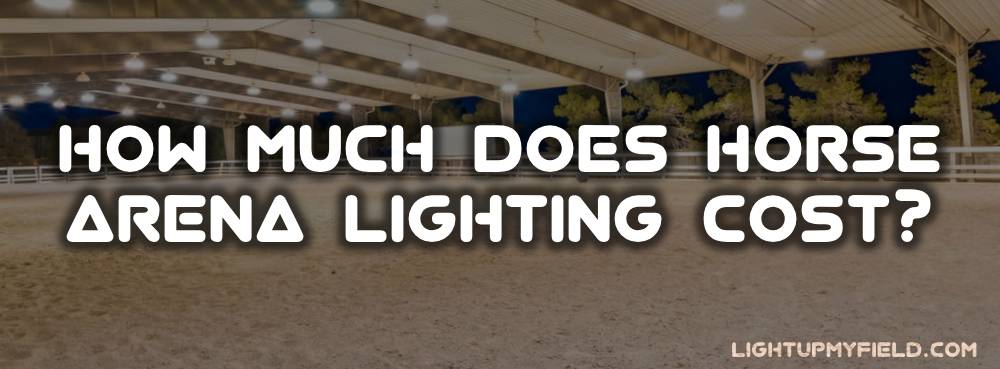If you’re thinking about lighting up your horse arena, one of the first questions that pops into mind is probably: how much is this going to set me back? Lighting isn’t just about hanging a few bulbs—it’s about creating a safe, functional, and sometimes competition-ready space that works for your horses, riders, and even spectators. Costs can vary a lot depending on your arena size, purpose, and the type of lighting you choose, so it’s worth taking a closer look before you make any decisions.
Table of Contents
ToggleWhy Do We Need to Consider the Cost?
Lighting isn’t a one-and-done expense. Beyond the upfront installation, there are ongoing energy bills, maintenance, and potential upgrades over time. Knowing the costs upfront helps you budget better and make decisions that won’t surprise you down the line. For example, if you’re only using your arena for a few casual evening rides a week, you might not need the same intensity as a full-scale competition arena. On the flip side, installing lights that are too dim or poorly placed can compromise safety and usability, which ends up being more expensive if you need to fix mistakes later.
Thinking about cost also gives you a chance to explore options that save money over time—like energy-efficient LEDs, solar-powered fixtures, or even portable light towers that can move between arenas or other events. Understanding the full picture of costs, from installation to running and maintenance, makes the whole investment smarter.
Average Horse Arena Lighting Cost
When it comes to lighting a horse arena, the numbers can add up fast. From the price of fixtures to installation, electricity, and maintenance, understanding the full picture can save you from surprises and help you budget smarter.
Lighting Cost
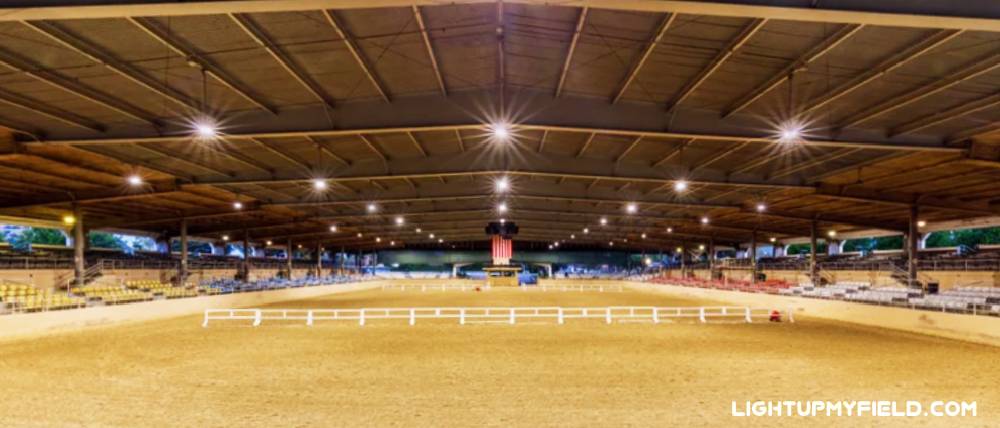
The type and number of lights you choose will be the biggest driver of your budget. Standard LED fixtures for arenas typically range from $150 to $500 each, depending on brightness, durability, and weather resistance. For a small recreational arena, you might only need 8–12 lights, which brings the hardware cost to roughly $1,200–$6,000. On the other hand, larger competition arenas demand 20–40 high-output fixtures to ensure even illumination for riders and judges, pushing costs to $10,000–$20,000 or more.
It’s also worth noting that specialty fixtures, like floodlights with dimming controls, motion sensors, or color-corrected bulbs for filming and photography, can add another $200–$400 per light, especially if you want a setup that’s versatile for multiple uses.
Installation Cost
Installing the lights can sometimes surprise arena owners. Indoor arenas with wall-mounted lights are generally easier, but outdoor arenas with freestanding poles require concrete footings and professional labor. Pole height is a major factor—taller poles for large outdoor arenas need heavier bases, cranes for lifting fixtures, and specialized wiring, which all add to the bill.
For smaller recreational setups, installation may run around $5,000, while a full competition-grade arena could cost $15,000–$25,000 or even higher. Adding multiple lighting zones, dimming controls, or automated timers increases labor and wiring costs, potentially tacking on another $3,000–$5,000.
Don’t forget hidden installation costs either. These can include permits or inspections, which vary by city or county and might add $200–$1,000, as well as site prep, like leveling the ground or trenching for electrical lines, which can run $1,000–$3,000 for outdoor arenas.
Running Cost
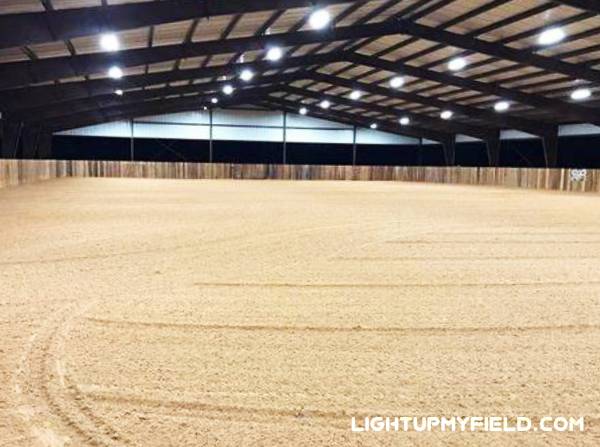
Even with energy-efficient LEDs, electricity costs aren’t zero. A recreational arena used 10–15 hours a week might spend around $20–$50 per month on electricity. Competition arenas hosting long events multiple nights a week could see bills of $200–$500 per month.
Using timers, motion sensors, or solar-powered fixtures can help lower these numbers. For example, adding a timer that automatically shuts off lights during breaks or when the arena isn’t in use can cut energy use by 20–30%, which could save $50–$100 per month in larger arenas.
Maintenance Cost
LEDs are generally low-maintenance, but arenas still require regular attention. Cleaning fixtures, checking wiring, and replacing bulbs when necessary adds up. Small recreational setups typically cost $200–$500 per year for maintenance, while high-output competition arenas could exceed $1,000 annually. Outdoor arenas may face extra wear from storms, snow, or UV exposure, which can increase maintenance costs by another $200–$400 annually.
Hidden Costs to Consider
Some of the more subtle costs can catch arena owners off guard. Upgrading your electrical panel to handle new lighting loads could run $1,500–$5,000, depending on capacity and local codes. If you want backup power for evening events or emergencies, a generator or battery storage system could add another $5,000–$15,000. Even insurance premiums can rise slightly when your arena includes high poles, powerful floodlights, or solar equipment.
Other hidden costs include fixture shipping, mounting hardware, and surge protection, which can collectively add $500–$1,500, especially for larger outdoor setups.
| Category | Small/Recreational | Training/Schooling | Competition | Outdoor Multipurpose |
|---|---|---|---|---|
| Fixtures | 8–12 LED ($1,200–$6,000) | 12–24 LED ($6,000–$12,000) | 20–40 high-output LED ($15,000–$25,000) | 15–30 LED or portable ($13,000–$30,000) |
| Specialty Fixtures | Optional $200–$400 each | Optional $200–$400 each | Often $200–$400 each | Optional $200–$400 each |
| Installation | ~$5,000 | $5,000–$8,000 | $15,000–$25,000 | $18,000–$30,000 |
| Hidden Installation Costs | $200–$3,000 | $200–$3,000 | $1,500–$5,000 (panels/permits) | $500–$3,000 |
| Running Costs (Electricity) | $20–$50 / month | $50–$100 / month | $200–$500 / month | $50–$400 / month |
| Maintenance | $200–$500 / year | $400–$800 / year | $1,000+ / year | $800–$1,500 / year |
| Total Cost Estimate | $5,000–$15,000 | $10,000–$20,000 | $25,000–$50,000+ | $20,000–$45,000+ |
| Lighting Level | 200–300 lux | 300–350 lux | 350–500 lux | 250–400 lux (variable/flexible) |
| Extras | Wall-mounted or short poles | Evenly spaced poles, dimming options | Glare reduction, motion zones, backup power | Portable towers, modular setup, solar options |
Costs for Different Purposes
Horse arena lighting isn’t a one-size-fits-all situation. The purpose of your arena plays a huge role in how bright the lights need to be, how many fixtures you’ll require, and, of course, how much you’ll end up spending. Let’s break it down.
Recreational Riding
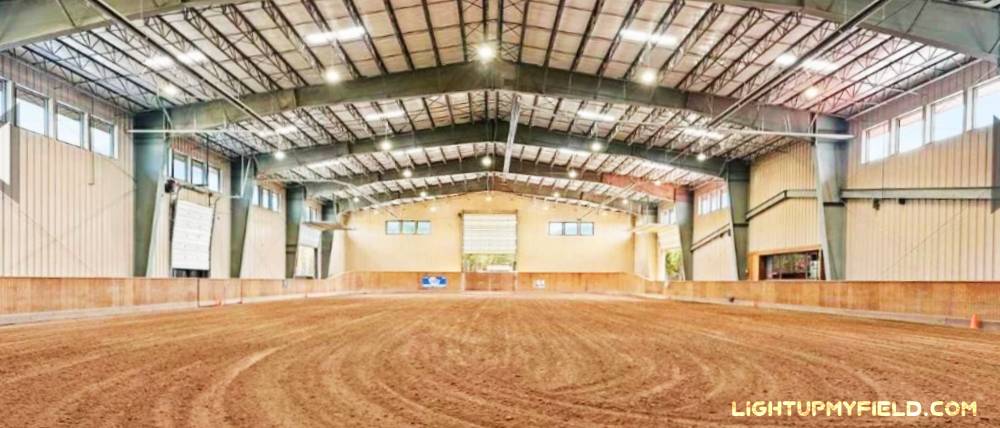
For those who just want a casual arena for evening rides or weekend practice, the lighting requirements are fairly modest. Most recreational setups aim for 200–300 lux, which is enough to see clearly without straining your eyes, but not so bright that it costs a fortune. You can often get away with 8–12 standard LED fixtures, keeping hardware costs around $1,500–$6,000.
Installation tends to be simpler too—wall-mounted lights or shorter poles are usually enough. Including installation, wiring, and running costs, a small recreational arena will often stay in the $5,000–$15,000 range, depending on size and whether you want dimming options or timers. Even with ongoing electricity bills of $20–$50 per month and occasional maintenance, it’s a manageable investment for hobby riders or private owners.
Training and Schooling Arenas
If your arena hosts regular lessons, riding schools, or adult training programs, lighting becomes a bigger deal. You’ll want around 300–350 lux to ensure every corner of the arena is well-lit for safety and clarity. That means more fixtures, probably spaced evenly across the space, so no dark patches interfere with lessons.
For a mid-sized training arena, the hardware cost alone can reach $6,000–$12,000, while installation with properly spaced poles and wiring might add another $5,000–$8,000. Running costs are higher too; if your facility operates 20 hours a week, electricity could run $50–$100 per month. Factoring in maintenance and occasional fixture replacements, total annual expenses may land in the $10,000–$20,000 range. Spending a bit more here pays off in safety and usability, especially for after-school programs or adult riding clubs that rely on evening hours.
Equestrian Competitions
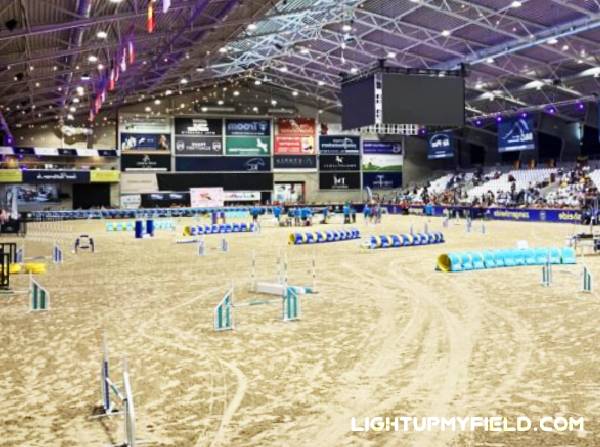 Competition arenas are a whole different ballgame. For official events, indoor shows, or arenas with spectators, you need bright, even lighting—often 350–500 lux or more. Uniformity is key; glare, shadows, or dark corners can affect rider performance and spectator experience. That means 20–40 high-output fixtures, sometimes with glare reduction or motion-detection zones, to keep everything lit perfectly.
Competition arenas are a whole different ballgame. For official events, indoor shows, or arenas with spectators, you need bright, even lighting—often 350–500 lux or more. Uniformity is key; glare, shadows, or dark corners can affect rider performance and spectator experience. That means 20–40 high-output fixtures, sometimes with glare reduction or motion-detection zones, to keep everything lit perfectly.
Hardware costs for a full competition arena can easily hit $15,000–$25,000, and installation, including tall poles, multiple lighting zones, and professional wiring, may add another $15,000–$25,000. Running a large arena for several nights a week can lead to monthly electricity bills of $200–$500, depending on hours of use. Add in maintenance, potential electrical panel upgrades, or even backup generators, and total costs can climb to $25,000–$50,000 or more. While it’s a big investment, the results are worth it if you’re hosting competitions or televised events where visibility matters for judges, participants, and spectators alike.
Outdoor Multipurpose Arenas
Some arenas aren’t just for riding—they host community events, fairs, clinics, or seasonal activities. In these cases, flexibility affects your budget. Using portable light towers, telescopic poles, or modular setups can cost an extra $3,000–$10,000 on top of standard fixture and installation expenses.
The advantage is you can move lights around, adjust coverage, or even use them at different venues, which may save money over time compared to installing permanent poles everywhere. For outdoor arenas exposed to the elements, you’ll also want weatherproof fixtures, which could add another $500–$1,500 depending on quality. Running costs can vary a lot, especially if you’re powering events for long evenings, but incorporating solar lights or timers can cut electricity bills by 30% or more.
Even with these extra costs, a multipurpose arena becomes far more versatile, allowing owners to host lessons, horse shows, or community events without constantly worrying about lighting limitations. The upfront investment pays off in flexibility, usability, and long-term savings.
What Determines the Cost of Lighting
When it comes to arena lighting, there’s no single price tag. A lot of moving parts decide how much you’ll spend, from the size of the arena to the type of fixtures you pick. Understanding these factors helps you plan smarter and avoid surprises down the line.
Arena Size and Layout
The size of your arena is probably the first thing that comes to mind. A small recreational arena of 60 by 20 meters might only need 8–12 lights, while a full competition arena of 80 by 40 meters could require 20–40 high-output fixtures to ensure even coverage. Bigger spaces mean more wiring, more poles, and more labor, which can easily double or triple installation costs. For example, a medium training arena might cost $10,000–$15,000 including fixtures and installation, while a full competition setup could push $30,000 or more.
Layout matters too. Outdoor arenas often need taller poles—sometimes 30 feet or more—to avoid dark spots, which requires deeper concrete footings and heavier-duty fixtures. Indoor arenas aren’t off the hook either; the distance between ceiling mounts or wall brackets and the beam angle of each light plays a huge role in both brightness and cost. Poorly spaced lights can leave shadows or uneven coverage, meaning you might have to add extra fixtures later.
Level of Competition
What you plan to do in the arena makes a big difference. Casual riding only needs enough light to see clearly, maybe 200–300 lux, which is achievable with basic LED fixtures. On the other hand, an arena hosting official competitions often requires 350–500 lux, uniform illumination, and even features like glare reduction or zoned lighting. Meeting these higher standards increases both the number and quality of lights you need.
Higher-level events also bring expectations for video broadcasts, judges, and spectator areas. That can mean more expensive, high-output fixtures and sometimes dimming or motion-controlled zones to manage light levels efficiently. The cost jump can be significant: casual setups may stay under $15,000, while a fully equipped competition arena could easily reach $50,000 or more once installation and running costs are included.
Pole Height and Mounting
Taller poles don’t just cost more to buy—they also cost more to install. A 20-foot pole for a medium arena is one thing, but a 30- to 35-foot pole for a competition arena requires stronger materials, deeper footings, and skilled labor, which can add $1,000–$3,000 per pole just in installation.
Indoor arenas have their own challenges. Ceiling height, mounting points, and spacing all affect how many lights you’ll need. A standard indoor arena with 10–12 mounting points might cost $1,500–$5,000 per zone, depending on the fixture quality. Beam angle is also a factor; narrow beams might leave dark spots, requiring additional lights, while wide-angle beams can cover more area but might be pricier.
Type of Lighting
Your choice of lighting technology has a huge impact on the bottom line. Traditional metal halide lights are cheaper upfront, maybe $100–$200 per fixture, but they consume more electricity and require replacement every 2–3 years. That adds up over time, especially for arenas used 20–30 hours a week.
LED lights, on the other hand, might cost $150–$500 per fixture, but they use 60–80% less energy and can last 15–20 years. That upfront investment can save thousands in running and maintenance costs over the long term.
For outdoor or multipurpose arenas, solar-powered or portable light towers are an option. They might cost an extra $3,000–$10,000 for the setup, but you can move them around, avoid trenching and heavy electrical work, and reduce electricity bills significantly. For example, using solar LED poles could cut annual running costs from $500 to $150 for a mid-sized arena.
Ways to Reduce the Cost
Lighting a horse arena doesn’t have to blow your budget. There are several ways to cut costs without sacrificing safety or performance, and a little planning can go a long way.
Energy-Efficient Fixtures
Switching to LED or solar-powered lights is the simplest way to save over time. A high-quality LED fixture might cost $200–$500 upfront, compared to a $100 metal halide lamp, but it uses about 70% less energy. That can shrink monthly electricity bills from $300–$500 for a competition arena down to $100–$150, which adds up to thousands in savings over a decade. Solar-powered options can take it even further. For example, a small outdoor arena using solar LED poles might see annual running costs drop to under $50, and you avoid trenching for electrical wiring entirely.
Grants and Rebates
There are often opportunities to get financial help from energy providers or local government programs. Rebates for energy-efficient lighting can range from a few hundred to several thousand dollars, depending on the project size. If your arena is tied to a school, riding club, or nonprofit, you could apply for grants that cover a significant portion of installation costs—sometimes $5,000–$10,000 or more. These programs aren’t always widely advertised, so it pays to check with local utilities or equestrian associations.
Phased Installation
If funding is tight, consider phasing your project. Start by lighting essential areas—like the main riding lanes or competition zones—then expand coverage later. For instance, a recreational arena might install 8 lights initially, then add 4–8 more in the future as the budget allows. This approach spreads out expenses and can prevent overspending upfront, while still improving usability right away.
Smart Layouts and Controls
How you position your lights can make a big difference in both cost and energy use. Efficient layouts mean fewer fixtures are needed to achieve uniform brightness, and installing motion sensors or lighting zones can cut running costs by 30–40%. For example, if a small indoor arena only lights the section in use for a 1-hour evening lesson, you could save $10–$20 per week, which adds up to hundreds annually. Dimming controls for different activities, like training versus casual riding, also help stretch your energy budget further.
Portable and Multi-Purpose Lighting
Investing in portable or multi-purpose lighting is another smart way to get more bang for your buck. Telescopic light towers or modular LED units can serve multiple arenas or events, which means you don’t have to buy separate fixtures for each area. For outdoor events, clinics, or community gatherings, these setups can cost $3,000–$10,000 upfront, but they offer flexibility and reduce the need for extra installation later. Essentially, you’re spreading the cost of each fixture across multiple uses, making your investment more efficient.
Maintenance and Longevity
Planning for maintenance can also save money in the long run. Choosing durable fixtures, scheduling annual checks, and cleaning lights regularly reduces the risk of expensive repairs or replacements. For a mid-sized arena, keeping up with preventive maintenance might cost $200–$500 a year, but ignoring it could lead to fixture replacements costing $1,500–$3,000 or more. A little attention early on pays off big over the life of the lighting system.
Bringing It All Together
Horse arena lighting can be a significant investment, but understanding the costs—from fixtures and installation to running and maintenance—helps you make smarter decisions and avoid surprises. A small recreational arena might stay under $15,000, while full competition setups can reach $50,000 or more. Knowing your needs in terms of brightness, flexibility, and energy efficiency can also help you uncover potential savings or funding opportunities.
The right lighting can make your arena safer, more versatile, and usable year-round. If you’re ready to explore options or want advice on the best setup for your space, contact us today. We’re happy to walk you through the possibilities, provide estimates, and help you create a lighting plan that works perfectly for your horses, riders, and events—without stretching your budget.

